Month: January 2019
Why Data Is Never Raw
Nick Barrowman at The New Atlantis:

The word data is derived from the Latin meaning “given.” Rob Kitchin, a social scientist in Ireland and the author of The Data Revolution (2014), has argued that instead of considering data as given it would be more appropriate to think of it as taken, for which the Latin would be capta. Except in divine revelation, data is never simply given, nor should it be accepted on faith. How data are construed, recorded, and collected is the result of human decisions — decisions about what exactly to measure, when and where to do so, and by what methods. Inevitably, what gets measured and recorded has an impact on the conclusions that are drawn.
For example, rates of domestic violence were historically underestimated because these crimes were rarely documented. Polling data may miss people who are homeless or institutionalized, and if marginalized people are incompletely represented by opinion polls, the results may be skewed. Data sets often preferentially include people who are more easily reached or more likely to respond.
more here.
A Small, Dark Miracle of a Book
Katherine Coldiron at 3:AM Magazine:
 How do you recommend an experience you never want to have again? How does a film critic say, for instance, that Requiem for a Dream is a must-watch, when it’s infused with such ugliness and despair? When a piece of art is unapologetically dark and unpleasant but of objectively excellent quality, finding a way to push audiences toward it is a challenge.
How do you recommend an experience you never want to have again? How does a film critic say, for instance, that Requiem for a Dream is a must-watch, when it’s infused with such ugliness and despair? When a piece of art is unapologetically dark and unpleasant but of objectively excellent quality, finding a way to push audiences toward it is a challenge.
In this vein is Thirty-Seven, by American novelist Peter Stenson, an intense, exceptionally well-made, unforgettable book. I loved every word, but I can’t suggest it’s an enjoyable read. It’s a horror story without ghosts or beasts, a book that continually evokes Rorschach, in Watchmen, saying “as dark as it gets.” Meticulously constructed, Hitchcockian in its layering of tension, Faulknerian in its network of ideas, wise and strange as an angel, black as a night in a dungeon. Certainly one of the best books I read in 2018. But difficult to recommend. At least, not if you’re looking for a comfortable ride.
more here.
The Digressive, Prescient Brilliance of DH Lawrence’s Essays
Geoff Dyer at the New Statesman:
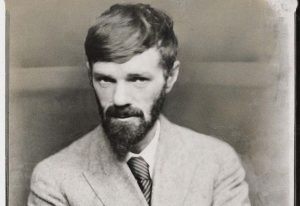 The best parts of “Art and Morality” (1925) are not about art or morality but – via an extraordinary speculative detour into the lives of ancient Egyptians – about how the “Kodak” habit of photographing oneself all the time has fundamentally changed our sense of ourselves: a prophetic diagnosis of a defining malaise of the iPhone era. In an editorial note to “Introduction to Pictures” the scholar James T Boulton rightly points out that the essay “does not once refer to pictures”. This tendency to stray from stated intentions was best expressed by Lawrence himself on 5 September 1914. “Out of sheer rage I’ve begun my book about Thomas Hardy. It will be about anything but Thomas Hardy I am afraid – queer stuff – but not bad.”
The best parts of “Art and Morality” (1925) are not about art or morality but – via an extraordinary speculative detour into the lives of ancient Egyptians – about how the “Kodak” habit of photographing oneself all the time has fundamentally changed our sense of ourselves: a prophetic diagnosis of a defining malaise of the iPhone era. In an editorial note to “Introduction to Pictures” the scholar James T Boulton rightly points out that the essay “does not once refer to pictures”. This tendency to stray from stated intentions was best expressed by Lawrence himself on 5 September 1914. “Out of sheer rage I’ve begun my book about Thomas Hardy. It will be about anything but Thomas Hardy I am afraid – queer stuff – but not bad.”
Intended as part of a series called “Writers of the Day”, the manuscript, which had veered far from any template, was not accepted for publication. Lawrence wanted it to leave the original brief still further behind and began recasting something that had been “mostly philosophicalish, slightly about Hardy” into a more explicit statement of his “‘philosophy’ (forgive the word)”.
more here.
The Trouble with the New “Islamic Science”
Imad-ad-Dean Ahmad in Atlantis:
 The history of Islam’s relation to science has largely been one of harmony. It offers no real parallel to the occasional bouts of suspicion toward science that the Christian world experienced. Today, many Muslims can be found in the fields of medicine and engineering. Even the ultraconservative Muslims who long for a return to the ethical norms of the seventh century see no need to abandon cell phones to do so, and even the most extreme of Islamic extremists envies the high-tech oil-extraction techniques and the weaponry of the West. Muslims, both conservative and liberal, issue fatwas (legal opinions) over the Internet without any hesitation over the technology they employ and with no fear that it may be haram (prohibited).
The history of Islam’s relation to science has largely been one of harmony. It offers no real parallel to the occasional bouts of suspicion toward science that the Christian world experienced. Today, many Muslims can be found in the fields of medicine and engineering. Even the ultraconservative Muslims who long for a return to the ethical norms of the seventh century see no need to abandon cell phones to do so, and even the most extreme of Islamic extremists envies the high-tech oil-extraction techniques and the weaponry of the West. Muslims, both conservative and liberal, issue fatwas (legal opinions) over the Internet without any hesitation over the technology they employ and with no fear that it may be haram (prohibited).
However, although contemporary Muslims tend not to be averse to science or technology, their strong belief in the compatibility of science and Islam may leave them vulnerable to dubious efforts to equate the two. The effort to harmonize modern technical knowledge and practice with Islamic teaching is part of a project known as the “Islamization of knowledge,” and is quite popular among Muslim intellectuals today. The most visible area of this intellectual work has been in the world of finance, with the development of so-called “Islamic banking.” A wide variety of venture-capital investments, joint-development projects, and partnership financing have been devised to avoid the appearance of charging interest, a practice forbidden by traditional Muslim jurisprudence. On a smaller scale, there has been a rising interest in bringing the sciences into a conversation with Islamic teachings.
An offshoot of this project takes an absurd turn: it attempts to demonstrate, in effect, that the Koran is a scientific textbook — that it is not merely compatible with science but actually foretells and validates specific modern scientific theories. This movement is troubling in part because it is becoming associated with the term “Islamic science,” which has long been used to refer to the medieval Golden Age during which the Muslim world made important contributions to natural philosophy, medicine, and mathematics. Confusing this new movement with that important period is a disservice to history. Moreover, this new movement to seek out science in the Koran is contrary to the scientific method and, in ignoring the Koran’s warning against confusing allegory with basic facts (3:7), is contrary to Islamic teaching.
More here.
Germs in Your Gut Are Talking to Your Brain
Carl Zimmer in The New York Times:
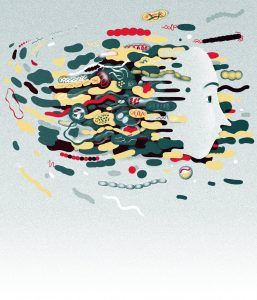 In 2014 John Cryan, a professor at University College Cork in Ireland, attended a meeting in California about Alzheimer’s disease. He wasn’t an expert on dementia. Instead, he studied the microbiome, the trillions of microbes inside the healthy human body. Dr. Cryan and other scientists were beginning to find hints that these microbes could influence the brain and behavior. Perhaps, he told the scientific gathering, the microbiome has a role in the development of Alzheimer’s disease. The idea was not well received. “I’ve never given a talk to so many people who didn’t believe what I was saying,” Dr. Cryan recalled. A lot has changed since then: Research continues to turn up remarkable links between the microbiome and the brain. Scientists are finding evidence that microbiome may play a role not just in Alzheimer’s disease, but Parkinson’s disease, depression, schizophrenia, autism and other conditions.
In 2014 John Cryan, a professor at University College Cork in Ireland, attended a meeting in California about Alzheimer’s disease. He wasn’t an expert on dementia. Instead, he studied the microbiome, the trillions of microbes inside the healthy human body. Dr. Cryan and other scientists were beginning to find hints that these microbes could influence the brain and behavior. Perhaps, he told the scientific gathering, the microbiome has a role in the development of Alzheimer’s disease. The idea was not well received. “I’ve never given a talk to so many people who didn’t believe what I was saying,” Dr. Cryan recalled. A lot has changed since then: Research continues to turn up remarkable links between the microbiome and the brain. Scientists are finding evidence that microbiome may play a role not just in Alzheimer’s disease, but Parkinson’s disease, depression, schizophrenia, autism and other conditions.
For some neuroscientists, new studies have changed the way they think about the brain. One of the skeptics at that Alzheimer’s meeting was Sangram Sisodia, a neurobiologist at the University of Chicago. He wasn’t swayed by Dr. Cryan’s talk, but later he decided to put the idea to a simple test. “It was just on a lark,” said Dr. Sisodia. “We had no idea how it would turn out.” He and his colleagues gave antibiotics to mice prone to develop a version of Alzheimer’s disease, in order to kill off much of the gut bacteria in the mice. Later, when the scientists inspected the animals’ brains, they found far fewer of the protein clumps linked to dementia.
Just a little disruption of the microbiome was enough to produce this effect. Young mice given antibiotics for a week had fewer clumps in their brains when they grew old, too.
More here.
A Puzzle about Ancient Cynicism
by Scott F. Aikin and Robert B. Talisse
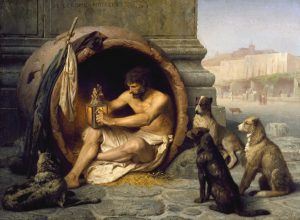
Diogenes of Sinope famously walked the streets of Athens searching for an anthropos. The tale is regularly rendered as him looking for an honest man, but this is too restrictive a translation. Rather, he was looking for a human, in the thick sense of the word. It is like a coach of a soccer team, challenging the squad of players, asking them if they are soccer players. In this regard, the thick sense of the term bears a normative weight, as a success term. And so, when one points to Lionel Messi and says, “Now, that’s a soccer player,” one is not merely saying that Messi plays the game. Rather, one is saying that he plays excellently, that he is exemplary. And so, when Diogenes, with his lit lamp in the daylight, asks people he meets if they are human beings, he is using the term in the thick sense. And given that his search seems to be ongoing, he implicates that everyone is failing to live up to the standard.
The standard that Diogenes — and with him, the ancient Cynic tradition — had in mind is not clear. However, one value at the center of this thick notion of humanity is not in question: that of autarkeia, roughly, independence, self-sufficiency, freedom. The genuine human is free; but, again, Diogenes finds no one fulfilling that standard. Instead, he finds people who are who have lost or given away their independence. Hence a famous Cynic paradox: only the practicing Cynic is free, only the Cynic is rich. How to make sense of these claims? Read more »
A Love Poem
by Amanda Beth Peery
Ms Green isn’t any good with
love poems or tokens, doesn’t like
small, easily lost objects. So she wants
to give him her visions—for example
the wedge of park & slim streetlights
shattering in shallow rainwater
like swarms of bottled fireflies
or clusters of leaping stars.
She wants to give him her gratitude
for life itself: darkness broken by light
days broken by night. The pattern of
dark leaves pressed against the sky.
Here Goes Everything
by Tim Sommers
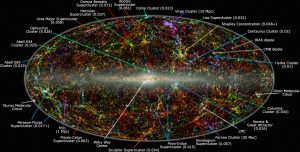 I know you’ve heard this before. But it’s just too relevant to avoid, so, please, bear with me. It may, or may not, be a garbled version of something Bertrand Russell wrote in Why I am not a Christian, but it has become the equivalent of an urban legend in philosophy. It goes like this. Some famous philosopher or another, maybe Russell, maybe William James, is traveling in some non-Western country, probably India, because of the elephants, and they ask a local informant about their cosmology. The local says, “We believe that the world is a vast sphere resting on the back of four great elephants.”
I know you’ve heard this before. But it’s just too relevant to avoid, so, please, bear with me. It may, or may not, be a garbled version of something Bertrand Russell wrote in Why I am not a Christian, but it has become the equivalent of an urban legend in philosophy. It goes like this. Some famous philosopher or another, maybe Russell, maybe William James, is traveling in some non-Western country, probably India, because of the elephants, and they ask a local informant about their cosmology. The local says, “We believe that the world is a vast sphere resting on the back of four great elephants.”
The philosophy professor says, “But what are the elephants standing on?”
“The elephants are standing on the back of an enormous turtle.”
“What’s the turtle standing on?”
“An even larger turtle.
“But what is that turtle standing on?”
“You are very clever, sir, but I’m afraid it’s turtles all the way down.”
What is that so relevant to? Maybe, the cosmological argument for the existence of God, for one thing, but certainly this. Either the universe has existed in some form or another forever or the universe came into existence out of nothing at some point. That’s not physics or even cosmology. That’s logic. P or not P. Either some turtle is standing on nothing or it’s turtles all the way down. Read more »
Perceptions
I am attempting to Come to Terms with this Big Failure
by Niall Chithelen
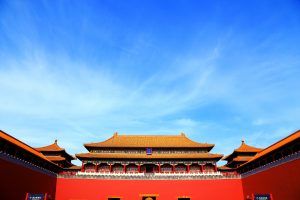
1) I got to see a different side of the Forbidden City when I brought visitors to there on a Monday and learned that the Forbidden City is not open to the public on Mondays. The side of the city that I saw was the outside, because Plan B (improvised) was to walk around the Forbidden City to the park behind it, which amounts largely to walking alongside a large, wide gray wall. Truly remarkable, you know, the immaculate geomancy, the imperial wonders and golden roofs. And then the wall and then us on the other side, strolling around as though I did not just commit a grave and truly ignominious error—strolling in pained, weak silence.
2) On any informal tour I lead, I like to show people the real China, you know, not just the tourist spots. Some people might like to see the inside of the Forbidden City, but for most of its existence, common people could not see the Forbidden City, and so it is more appropriate, I think, to walk around it, as a person would have two or three hundred years ago in order to do whatever business or activity people did at that time in this city—perhaps involving carts, or administration, or workplace conflict resolution. I am not sure about this. This is a more legitimate experience—no ticket required—just a channel into Beijing, feet on the ground in this old city, eyes on those old buildings that have seen so many years of change, an injection of pure Beijing right into your goddamn veins, really. And I try to be informative and even-handed as I dole out history and explain contemporary developments. Is China perfect? No. Is the US perfect? Also no. It is so difficult to judge these things. Read more »
Catspeak
by Brooks Riley

In the Agora of Socrates
by Shadab Zeest Hashmi
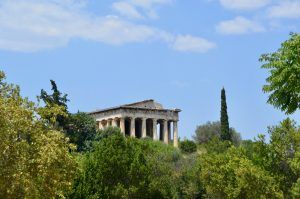 No one knows if it was really in the state prison, the ruins of which are visible today outside the ancient Agora of Athens, that Socrates was kept during the final days before his execution, so many times has the area been destroyed and reconstructed— walking past it sends a chill down my spine. Ancient Greece is visceral and vivid because it entered my imagination early in life; some of the most cherished tales of my childhood came from the crossovers of Hellenistic history and legend, such as the one in which Sikander (Alexander the Great) is accompanied by the Quranic Saint Khizr, in pursuit of “aab e hayat,” the elixir of immortality, or the one about the elephantry in the battle between Sikander and the Indian king Porus, or of the loss of Sikander’s beloved horse Bucephalus on a riverbank not far from Lahore, the city where I was born. I became familiar with ancient Greece through classical Urdu poetry and lore as well as through my study of English literature in Pakistan, but I would read Greek philosophers in depth many years later, as a student at Reed college; I would subsequently discover Greek influence on scholars in the golden age of Muslim civilization while working on a book on al-Andalus— the overlooked, key contribution of Arabic which served as a link between Greek and Latin, and its later offshoots that came to define the cultural and intellectual history of Europe.
No one knows if it was really in the state prison, the ruins of which are visible today outside the ancient Agora of Athens, that Socrates was kept during the final days before his execution, so many times has the area been destroyed and reconstructed— walking past it sends a chill down my spine. Ancient Greece is visceral and vivid because it entered my imagination early in life; some of the most cherished tales of my childhood came from the crossovers of Hellenistic history and legend, such as the one in which Sikander (Alexander the Great) is accompanied by the Quranic Saint Khizr, in pursuit of “aab e hayat,” the elixir of immortality, or the one about the elephantry in the battle between Sikander and the Indian king Porus, or of the loss of Sikander’s beloved horse Bucephalus on a riverbank not far from Lahore, the city where I was born. I became familiar with ancient Greece through classical Urdu poetry and lore as well as through my study of English literature in Pakistan, but I would read Greek philosophers in depth many years later, as a student at Reed college; I would subsequently discover Greek influence on scholars in the golden age of Muslim civilization while working on a book on al-Andalus— the overlooked, key contribution of Arabic which served as a link between Greek and Latin, and its later offshoots that came to define the cultural and intellectual history of Europe.
Visiting the Agora in the sweltering heat of July, I am amazed by how comfortably these ruins from over two thousand years are nestled in the modern landscaping, park benches and pavements, how familiar the patchy, intensely green grass is, the deep, somnolent shade of oaks— the ancient is home once again, brought down to a child’s scale, at once snug and phantasmagoric, historic and pulsating with new life. Read more »
Monday Photo
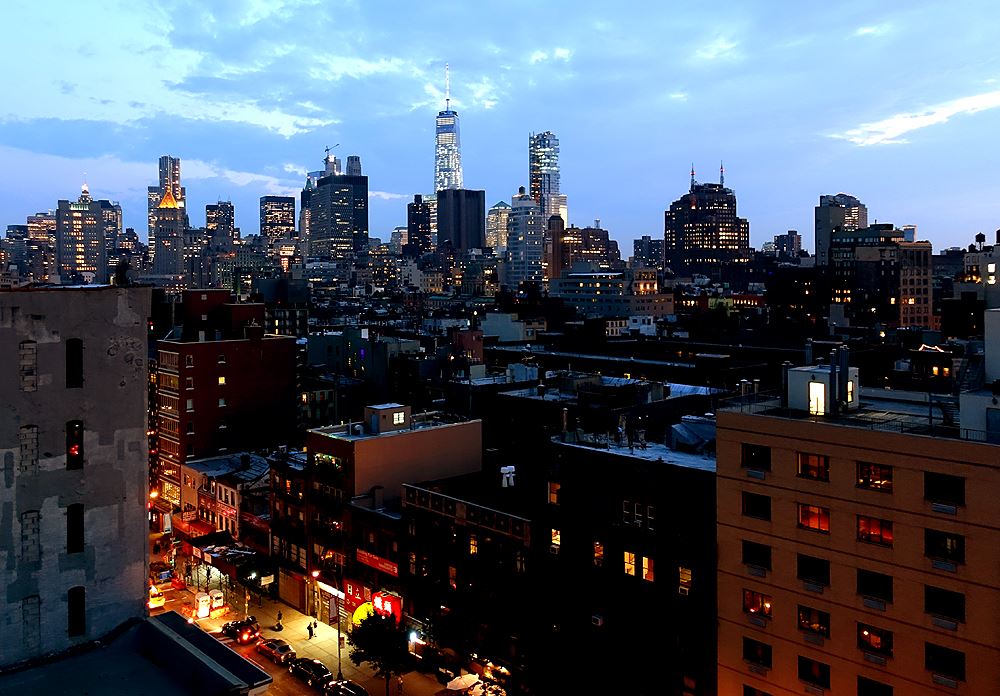
New York City at twilight from the top of the New Museum in July, 2016.
More Death
by Nickolas Calabrese
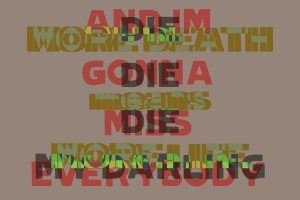 1. “…And I, who timidly hate life, fascinatedly fear death.” Fernando Pessoa, The Book of Disquiet.
1. “…And I, who timidly hate life, fascinatedly fear death.” Fernando Pessoa, The Book of Disquiet.
2. I didn’t ask to be born, yet I’ve been condemned to death. Early on in Plato’s Phaedra, Socrates declares that it’s the job of the philosopher to prepare for death. Addressing Simmias and Cebes he states, “I am afraid that other people do not realize that the one aim of those who practice philosophy in the proper manner is to practice for dying and death.” There is something vulgarly sunny in the way he suggests it, but it also rings clearly true. What philosophers talk about when they talk about ‘the good life’ is a life not regretted when it comes time to exit it. Theirs is the pursuit of truth and understanding, and our own mortality could not be a more present topic to pursue.
3. Quite a few artists are engaged in a similar investigation. Although theirs is not as pure as the philosophers’, the good ones have a strong tendency to make work that both eviscerates vanity and frames mortality. By its very nature, the subject becomes the object. The countless examples of musicians, artists, poets, etc., examining the finitude of their own lives constitutes a vast list. Those who have spent time producing work in this vein are legion: from Bob Dylan to Future, from John Donne to Amiri Baraka, from Cady Noland to Andy Warhol. It comes as no surprise that one’s own death is an attractive topic. After all it’s something that every person ever has either done or will do in their lives. Death is more common than emotions. Not all people are capable of, say, love, but everyone must die. But what artists try to do with their work is antithetical to what Socrates was defining: artists are trying to cheat death. I’ll say more about this further down. Read more »
Lab-grown meat’s steady march to your plate
Matt Davis in Big Think:
 Lab-grown beef may very well be the path forward. In 2008, it was estimated that just half a pound of lab-grown beef would cost $1 million. Then, on August 5, 2013, the first lab-grown hamburger was eaten. It cost $325,000 and took two years to make. Just two years later, the same amount of lab-grown beef costs about $11 to make.
Lab-grown beef may very well be the path forward. In 2008, it was estimated that just half a pound of lab-grown beef would cost $1 million. Then, on August 5, 2013, the first lab-grown hamburger was eaten. It cost $325,000 and took two years to make. Just two years later, the same amount of lab-grown beef costs about $11 to make.
Lab-grown beef checks almost all of the boxes: it doesn’t require animal cruelty, and a study in Environmental Science and Technology showed that it could cut emissions from conventionally produced meat by up to 96 percent and cut down on the land use required for meat production by 99 percent. In the U.S., where cow pastures take up 35 percent of available land — that’s about 654 million acres — this could be huge. Imagine having 647 million acres for development, housing, national parks, anything at all!
But does lab-grown beef pass the most crucial test? Does it taste like an honest-to-goodness hamburger?
More here.
The Material Power of Ideas and Knowledge
Henry Farrell in Crooked Timber:
Attention conservation notice: long (nearly 5,000 words long) essay on the economic power of ideas. To its credit, the questions discussed are plausibly important. To its detriment, the arguments are less arguments than gestures, and the structure is decidedly baggy.
For the last couple of weeks, I’ve been wanting to write a response to Aaron Major’s (paywalled) article on ideas and economic power for Catalyst. Now there’s a second piece by Jeremy Adelman in Aeon on Thomas Piketty and Adam Tooze. I think they’re both wrong, but in different ways. Major’s piece suggests that economic ideas don’t really matter very much – it’s the economic base, not the superstructure that’s doing the work. Adelman, in contrast, think that ideas are super important – he just thinks that Piketty and Tooze have ones that are leading us in the wrong direction.
These arguments come from radically different places, but they have one thing in common. They both substantially underestimate the role that ideas have played in getting us to where we are on the left, and what they they’re likely to do for us in the near future.
More here.
The Left’s Choice
Dani Rodrik in Project Syndicate:
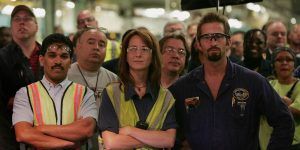 The main political beneficiaries of the social and economic fractures wrought by globalization and technological change, it is fair to say, have so far been right-wing populists. Politicians like Donald Trump in the United States, Viktor Orbán in Hungary, and Jair Bolsonaro in Brazil have ridden to power by capitalizing on the growing animus against established political elites and exploiting latent nativist sentiment.
The main political beneficiaries of the social and economic fractures wrought by globalization and technological change, it is fair to say, have so far been right-wing populists. Politicians like Donald Trump in the United States, Viktor Orbán in Hungary, and Jair Bolsonaro in Brazil have ridden to power by capitalizing on the growing animus against established political elites and exploiting latent nativist sentiment.
The left and progressive groups have been largely missing in action. The left’s relative weakness partly reflects the decline of unions and organized labor groups, which have historically formed the backbone of leftist and socialist movements. But ideological abdication has also played an important role. As parties of the left became more dependent on educated elites instead of the working class, their policy ideas aligned more closely with financial and corporate interests.
The remedies on offer from mainstream leftist parties remained correspondingly limited: more spending on education, improved social-welfare policies, a bit more progressivity in taxation, and little else. The left’s program was more about sugarcoating the prevailing system than addressing the fundamental sources of economic, social, and political inequities.
More here.
How to Escape Pseudo-Events in America: The Lessons of Covington
Joshua Rothman in The New Yorker:
 For around a decade, people who think critically about the media have worried about filter bubbles—algorithmic or social structures of information flow that help us see only the news that we want to see. Filter bubbles make it easy to ignore information that could change our views. But the Covington story is an example of a different problem. It’s a story that’s disproportionately talked about and hard to avoid. It’s relatively inconsequential, but also inescapable. There is no bubble strong enough to keep it out.
For around a decade, people who think critically about the media have worried about filter bubbles—algorithmic or social structures of information flow that help us see only the news that we want to see. Filter bubbles make it easy to ignore information that could change our views. But the Covington story is an example of a different problem. It’s a story that’s disproportionately talked about and hard to avoid. It’s relatively inconsequential, but also inescapable. There is no bubble strong enough to keep it out.
The Covington saga isn’t fake news, strictly speaking. The events on the Mall really happened; what’s more, the surrounding story raises many questions of broad, genuine interest. How much should we hold teen-agers accountable for their political views? Would a group of nonwhite demonstrators have been permitted to behave as the Covington boys did? What is the moral status of Catholicism, and of socially conservative religious institutions generally? (What if the boys had been students at a Jewish or Muslim school?) How reactive should journalists be? These subjects are interesting to debate, as are the reputations of Sandmann and Phillips. All of this lends the Covington video a kind of moral momentum. As more people weigh in, the momentum builds.
It would be wrong, however, to take the moral interest of the Covington video at face value.
More here. [Thanks to Dan Dennett.]
Michel Legrand (1932 – 2019)

